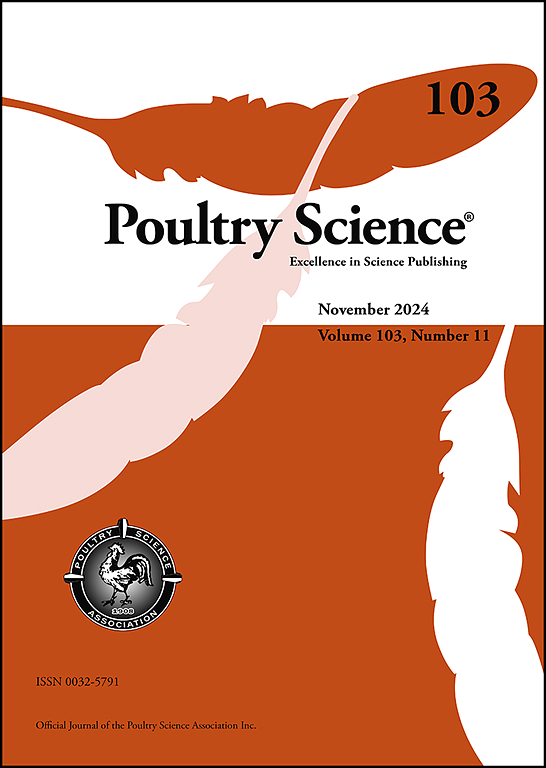The effects of formic acid or herbal mixture on growth performance, carcass quality, blood chemistry, and gut microbial load in broiler chickens
IF 3.8
1区 农林科学
Q1 AGRICULTURE, DAIRY & ANIMAL SCIENCE
引用次数: 0
Abstract
The purpose of this research was to assess the effects of formic acid (FORM) and an herbal mixture (HM) as antibiotic alternatives in broiler meals on growth efficiency, carcass criteria, blood parameters, and intestinal bacterial populations. A total of 360 one-day-old Ross 308 broiler chicks were assigned to six trial treatments using a totally randomized method. Each group consisted of 6 replicates, with 10 unsexed chicks per replicate. The groups were arranged as follows: NC (negative control, basal diet); PC (positive control, basal diet + 0.5 g Polymyxin E antibiotic/kg diet); Form2, Form4, HM3, and HM6 (basal diet supplemented with 2 or 4 ml formic acid, or 3 or 6 g herbal mixture/kg diet, respectively). The findings showed no substantial variations in "body weight (BW) or body weight gain (BWG)" among the formic acid and herbal mixture groups relative to the NC and PC groups. The HM 3 and 6 g/kg groups exhibited higher "feed intake (FI) and improved feed conversion ratio (FCR)" relative to the other treatments. Carcass characteristics were not substantially impacted by formic acid or herbal mixture supplementation, except for spleen weight, which was highest in the NC group. Significant changes in blood parameters were observed, with notable variations in ALT and AST activity and "urea, creatinine, total protein, globulin, and albumin" levels in the formic acid and herbal mixture groups. The supplementation of formic acid and herbal mixture also increased antioxidant levels (GPx, GST, and GSH) compared to the NC group while reducing MDA levels relative to the NC and PC groups. Additionally, formic acid supplementation significantly reduced harmful bacterial populations in cecal samples. Conversely, Lactobacilli counts greater than those in the NC and PC groups, although no significant variances in Clostridium populations were observed. In conclusion, supplementing broiler feed with formic acid and herbal mixtures positively influences blood parameters, antioxidant status, and intestinal microbiota.
本研究的目的是评估甲酸(FORM)和中草药混合物(HM)作为肉鸡饲料中抗生素替代品对生长效率、胴体标准、血液参数和肠道细菌群的影响。采用完全随机的方法,将 360 只一天龄的罗斯 308 肉鸡分配到六个试验处理中。每组有 6 个重复,每个重复有 10 只无性别雏鸡。各组安排如下NC(阴性对照,基础日粮);PC(阳性对照,基础日粮 + 0.5 克多粘菌素 E 抗生素/千克日粮);Form2、Form4、HM3 和 HM6(基础日粮中分别添加 2 或 4 毫升甲酸,或 3 或 6 克中草药混合物/千克日粮)。研究结果表明,相对于 NC 组和 PC 组,甲酸组和草药混合物组在 "体重(BW)或体重增加(BWG)"方面没有显著差异。与其他处理相比,HM 3 和 6 g/kg 组表现出更高的 "采食量(FI)和饲料转化率(FCR)"。胴体特征并未受到甲酸或中草药混合物添加剂的实质性影响,但脾脏重量除外,NC 组的脾脏重量最高。观察到血液参数发生了显著变化,甲酸组和草药混合物组的谷丙转氨酶(ALT)和谷草转氨酶(AST)活性以及 "尿素、肌酐、总蛋白、球蛋白和白蛋白 "水平变化明显。与 NC 组相比,补充甲酸和草药混合物还能提高抗氧化剂水平(GPx、GST 和 GSH),同时降低 MDA 水平。此外,补充甲酸还能显著减少盲肠样本中的有害细菌数量。相反,乳酸杆菌数量高于 NC 组和 PC 组,但梭状芽孢杆菌数量没有明显变化。总之,在肉鸡饲料中添加甲酸和草药混合物对血液参数、抗氧化状态和肠道微生物群有积极影响。
本文章由计算机程序翻译,如有差异,请以英文原文为准。
求助全文
约1分钟内获得全文
求助全文
来源期刊

Poultry Science
农林科学-奶制品与动物科学
CiteScore
7.60
自引率
15.90%
发文量
0
审稿时长
94 days
期刊介绍:
First self-published in 1921, Poultry Science is an internationally renowned monthly journal, known as the authoritative source for a broad range of poultry information and high-caliber research. The journal plays a pivotal role in the dissemination of preeminent poultry-related knowledge across all disciplines. As of January 2020, Poultry Science will become an Open Access journal with no subscription charges, meaning authors who publish here can make their research immediately, permanently, and freely accessible worldwide while retaining copyright to their work. Papers submitted for publication after October 1, 2019 will be published as Open Access papers.
An international journal, Poultry Science publishes original papers, research notes, symposium papers, and reviews of basic science as applied to poultry. This authoritative source of poultry information is consistently ranked by ISI Impact Factor as one of the top 10 agriculture, dairy and animal science journals to deliver high-caliber research. Currently it is the highest-ranked (by Impact Factor and Eigenfactor) journal dedicated to publishing poultry research. Subject areas include breeding, genetics, education, production, management, environment, health, behavior, welfare, immunology, molecular biology, metabolism, nutrition, physiology, reproduction, processing, and products.
 求助内容:
求助内容: 应助结果提醒方式:
应助结果提醒方式:


